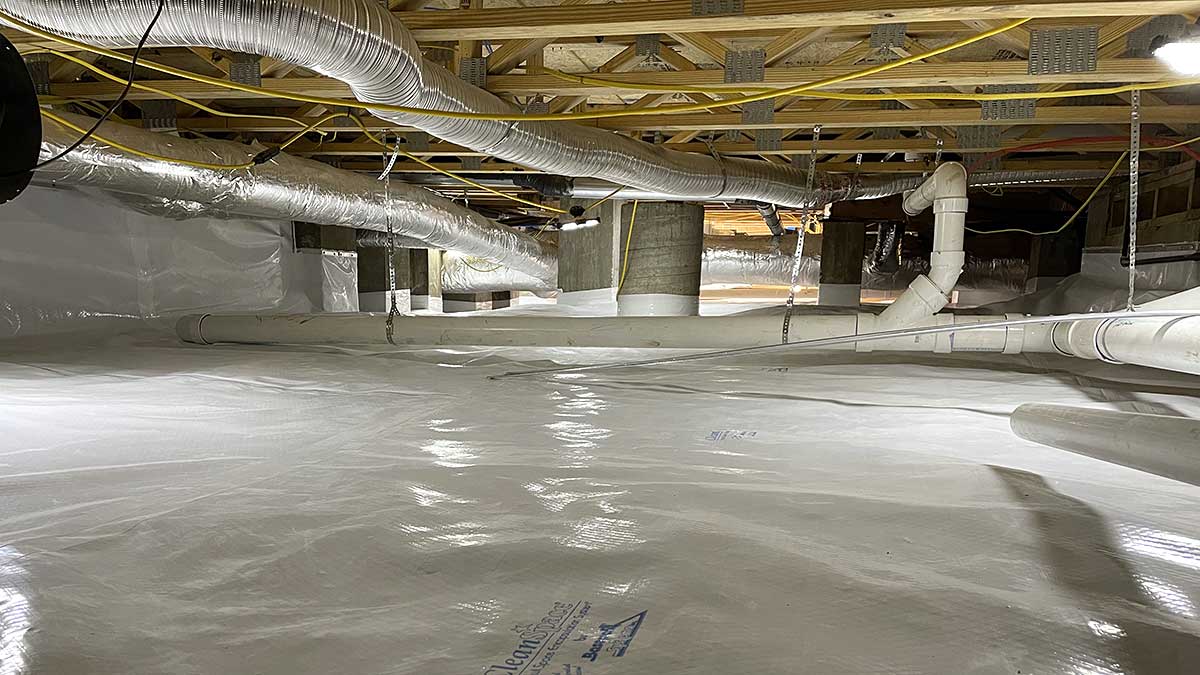Moisture is sneaky in Central Texas, and storms roll in fast. Summers are also humid, and water finds its way into crawl spaces and lingers with that humidity. That raises risk for mold, wood rot, pests, and high energy bills. Crawl space encapsulation stops that cycle and protects your home.
This guide explains the causes, the fix, and how to keep your crawl space dry all year in Austin and across Central Texas.
What causes crawl space moisture in Central Texas
Short answer. Surface runoff, humid outdoor air, and wet soil introduce moisture. Poor drainage and open vents make it worse.
Here is what we see most in Austin. Soil that slopes toward the foundation. Downspouts that dump water near the house. Heavy rain that seeps through block walls or under footings. Then the climate steps in. Humid air enters a cool crawl space and condenses on wood and ducts. Ground moisture also rises into the air if the floor is bare dirt.
Plumbing leaks add to the load. So do uninsulated ducts and unsealed rim joists. Over time, wet insulation sags. Odors creep up into living areas. Floors can cup or feel soft.
What is crawl space encapsulation?
Short answer. Encapsulation seals the crawl space from soil and outside air; bringing the crawl space into the building’s envelope. It adds drainage and controlled drying to keep humidity down.
A complete system includes a heavy vapor barrier across the ground and up the underpinning walls. Seams get sealed. Vents get closed. Gaps at piers and penetrations get air‑sealed. Most homes add dehumidification to the crawlspace.
Why it works. You block moisture from the soil. You stop humid air from entering. You give the space a way to dry in a controlled, efficient way. That helps your structure, your air quality, and your energy budget.
“Conditioned crawlspaces perform better than vented crawlspaces in terms of safety, health, comfort, durability, and energy consumption.” Building Science
Do Austin homes still need crawl space vents?
Short answer. Usually no. In our humid climate, open vents pull in wet air and raise humidity. A sealed, conditioned crawl space performs better when it is built as a system. That means water management outside, a sealed liner, and active humidity control inside. Building Science
The must‑have components of an effective system
Use this checklist when you compare proposals.
- Exterior water/drainage management
Grade the soil to move water away from the house. Keep gutters clean. Extend downspouts well past the foundation. - Interior crawlspace drainage
For extreme drainage issues, providing crawlspace drainage may be needed, which would include routing water to a sump pump with a check valve and a safe discharge point. - Vapor barrier
Install a durable liner on the crawlspace floor and up onto the underpinning, typically 10 to 20 mil or thicker. Seal seams. Wrap and seal to piers and walls. - Air sealing and insulation
Seal vents and penetrations. Insulate rim joists and the crawl space underpinning perimeter with non‑water‑sensitive materials; stopping air infiltration and reducing the exterior thermal drive. - Dehumidification
Use a crawl‑space‑rated dehumidifier with a drain. Target relative humidity under 50 percent. The keys are moisture control, airtight construction, and complete insulation coverage. ENERGY STAR - Monitoring
Place a hygrometer in the crawl space. Check readings seasonally and after big storms.
Pro tip: Pair crawlspace encapsulation with a “Home Energy Audit” to unvent your attic space and reduce air leakage in your building envelope. That is how you lock in comfort and savings across the whole house.
Seasonal maintenance for Austin and Central Texas
Spring
Clean gutters. Extend downspouts. Inspect the crawlspace liner and tape seams. Test the sump pump and backup power.
Summer
Check humidity weekly during heat waves. Aim to stay under 50 percent RH. Look for condensation on ducts or pipes. Service the dehumidifier.
Fall and Winter
Recheck grading after heavy rains. Seal any new gaps in plumbing or cable penetrations. Confirm the dehumidifier drain is clear.
Keeping humidity low helps your health and your home. EPA recommends staying below 60 percent, with 30 to 50 percent ideal when possible.
When to call a retrofit contractor
Call a pro if you see standing water. Call if floors feel spongy or you suspect mold. Call if a prior liner failed or if you still smell musty odors. Our qualified team will evaluate grading, drainage, vapor intrusion, air leaks, and the right size dehumidifier.
Call us today for a free home energy consultation!
FAQs
Does crawl space encapsulation really help in Austin?
Yes. In a humid climate, sealing the ground and underpinning walls and controlling RH reduces mold risk, improves comfort, and can lighten HVAC load when paired with air sealing.
Do I still need a dehumidifier after encapsulation?
In most Austin homes, yes. Keep RH below 60 percent. Many homeowners target 45 to 50 percent for a safety margin.
Will encapsulation improve indoor air quality?
It can help by removing moisture that feeds mold and pests. Combine it with duct sealing and filtration for the best results. If your HVAC unit and ductwork are in the crawlspace, it will tremendously help with the air quality of the house. See our IAQ upgrades: https://texasretrofits.com/services/indoor-air-quality and learn more at the Environmental Protection Agency
How is this different from a vapor barrier only?
A liner without drainage, air sealing, and humidity control is not a system. Encapsulation ties all those parts together so moisture has no easy path in.
Should I upgrade insulation, too?
Often yes. Insulating the crawl underpinning perimeter and rim joists with the right materials supports steady conditions and energy savings.
Ready to dry out your crawl space?
Book a free evaluation. Get a clear plan, firm pricing, and a system built for Central Texas.
Sources
- U.S. EPA. “Mold Course: Humidity.” Environmental Protection Agency
- Building Science Corporation. “BA‑0401: Conditioned Crawlspace Construction, Performance and Codes.” Building Science
- ENERGY STAR. “Technology Fact Sheet: Crawlspace Insulation.” ENERGY STAR
